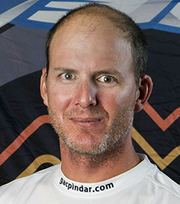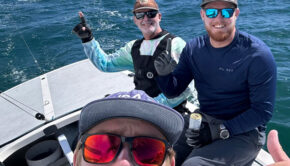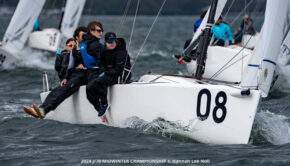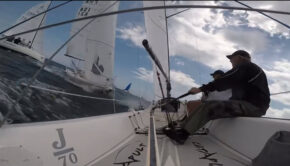Bill Hardesty: Different Boats, Same Outcome
Published on November 9th, 2015
 Bill Hardesty was on the winning teams for both the J/70 World and Melges 20 World Championships in 2015, increasing his total of world titles to twelve. Scuttlebutt editor Craig Leweck checked in with Bill to learn about these two programs and the differences between the classes.
Bill Hardesty was on the winning teams for both the J/70 World and Melges 20 World Championships in 2015, increasing his total of world titles to twelve. Scuttlebutt editor Craig Leweck checked in with Bill to learn about these two programs and the differences between the classes.
Let’s start with preparation.
The one big aspect that stands out for both programs is that we only spend time (and money) if it’s going to be productive and make an improvement to our performance. This takes careful planning, coordinating with quality tuning partners, and requires constantly evaluating our performance and deciding if we are meeting our goals. It’s always in the back of my mind that somebody somewhere is working harder and might be catching up.
Explain the team makeup.
The biggest commonality between the two teams is that we have professional crews with amateur helmsman. With these types of teams it’s important to keep the plan simple and communicate with a clear and concise words. If ever we need a little extra something, like a quick maneuver, we’ve sailed enough together, I know these guys, their abilities, and we can usually get the job done. I’m very fortunate to have the best guys in the world on my teams and they really don’t need much guidance.
How does your role as tactician vary between the two boats?
The biggest difference on a three person boat like the Melges 20 is I have a bigger boat handling role. Unfortunately, this has me sometimes working through a maneuver and I rely on feel to understand what else is happening in the boat.
It’s much harder going from the 4-person J/70 to the 3-person Melges 20. In the M20, my role is bigger with more rig tuning, more pulling, and that extra person on the J/70 can help a lot with all of the little tasks. When I get back in the J/70, I’m always surprised how simple they are and how my boat handling role is reduced.
How else are the two classes different?
The Melges 20 is comfortable, physical, and exciting. While the M20 is not known for its upwind excitement, you will get plenty of excitement when you turn downwind. The J/70 is much heavier and narrower. The J/70 will probably sail upwind slightly better, but it would be wind and wave dependent as which boat actually performed better.
Unfortunately, the J/70 has a deck layout that does not sync well with how the boats are being sailed. It seems the original design was a three person boat where the driver trims that main, traveler, backstay, and grinds the jib sheet (which is on the winch). In reality the boat is a four or five person boat, as it needs the crew weight, the winch is now not used, and it is hard to separate the other roles because of their location. Oh well…
Another big difference is in the performance feeling. The Melges 20 is like a sports car, making it more demanding and harder to master. The J/70 is a like a nice performing mini-van. I own both types of cars and love both for their intended purpose. This analogy holds true as not many family teams race the Melges 20 but you will see lots of families out racing the J/70.
Most of the top professional sailors have crewed in the Melges 20 at some point, but there are strict regulations on who can drive, most importantly the driver has to be an amateur and a boat owner. To drive the J/70 you technically only have to own 50% of the boat and pay 50% expenses. You see a lot more professionals buying J/70s and driving but with the real owner on the rail as crew.
Fairing of the hull and other technical issues are still being sorted. The class rules for both classes are clearly written but they are being enforced very differently. I personally prefer a measurement class where there are tolerances that are black and white.
You’d previously won the Farr 40 World Championship. How does your role adjust between the small and big boats?
Life has a funny way of being cyclical. Most of us start in smaller boats and eventually struggle to learn bigger boats. Some go the other way but that is rarer. I started in dinghies so the step back to smaller boats is much more natural.
When the crew size gets larger, and you have eight or more people, it seems there is so much more team management. The bigger the team, the more the plan needs to be communicated early and often. This could be a race maneuver or something as simple as a dinner plan. The pre-race routine is different and the ability to implement change is different. I thrive on challenge, big or small!
You race your own Etchells. Have any interest in shifting to the J/70 or Melges 20?
I would never be approved as an owner/driver in the Melges 20 class so that answer is easy. I’ve thought seriously about buying a J/70, or even a couple of boats, and trying to bring some of my work to my home waters with coaching and chartering. That would drastically change my current business model so I’m a bit hesitant. I plan to casually sail in the Etchells class as it is still very popular and has been good to me. We will have to wait and see where I end up with my own driving. Life and my time is different now that we have a one year old boy.









 We’ll keep your information safe.
We’ll keep your information safe.